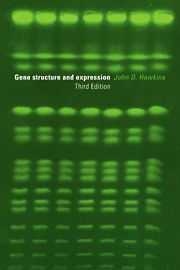Book contents
- Frontmatter
- Contents
- Introduction to the third edition
- Introduction to the second edition
- Introduction to the first edition
- List of abbreviations
- 1 Deoxyribonucleic acid (DNA)
- 2 Ribonucleic acid (RNA)
- 3 Methodology
- 4 Prokaryotic DNA replication and gene expression
- 5 The operon concept
- 6 Eukaryotic gene organisation and replication
- 7 Eukaryotic transcription
- 8 Post-transcriptional processing of RNA
- 9 Oncogenes
- 10 Haemoglobin
- 11 Proteins of the immune system
- 12 Some gene families
- 13 Mitochondrial and chloroplast genomes
- 14 Different and evolving genomes
- Glossary
- Reading lists
- Index
13 - Mitochondrial and chloroplast genomes
Published online by Cambridge University Press: 05 June 2012
- Frontmatter
- Contents
- Introduction to the third edition
- Introduction to the second edition
- Introduction to the first edition
- List of abbreviations
- 1 Deoxyribonucleic acid (DNA)
- 2 Ribonucleic acid (RNA)
- 3 Methodology
- 4 Prokaryotic DNA replication and gene expression
- 5 The operon concept
- 6 Eukaryotic gene organisation and replication
- 7 Eukaryotic transcription
- 8 Post-transcriptional processing of RNA
- 9 Oncogenes
- 10 Haemoglobin
- 11 Proteins of the immune system
- 12 Some gene families
- 13 Mitochondrial and chloroplast genomes
- 14 Different and evolving genomes
- Glossary
- Reading lists
- Index
Summary
Mitochondria and chloroplasts contain single circular chromosomes that direct the synthesis of a number of proteins, and also some of the RNAs that are required for the process. There is good evidence that these genomes are descended from separate lines of endosymbiotic bacteria (azotobacter and cyanobacteria). However, many of the genes that were originally present in these hypothetical ancestors have been translocated to the nucleus, so that their products must be transported into these organelles.
Yeast mitochondrial genome
This is about 78 kbp long, encoding two rRNA molecules, a complete set of tRNAs, and mRNAs directing the synthesis of at least nine proteins (Fig. 13.1 and Table 13.1). The polymerases for the synthesis of mitochondrial DNA and RNA, all the tRNA synthetases and the majority of the mitochondrial proteins (e.g. the enzymes of the citrate cycle and electron transport chain) are encoded by nuclear genes and synthesised on cytoplasmic ribosomes. All these proteins contain amino acid sequences to target them for translocation into the mitochondria.
The mitochondrial rRNAs (21S, 3200 nt; and 15S, 1660 nt) are somewhat smaller than prokaryotic rRNAs, and there is no rRNA corresponding to the 5.8S rRNA of the cytoplasmic ribosomes. The two rRNAs are encoded on widely separated parts of the genome, and are not transcribed together. There are genes for 24 tRNAs, some of which are clustered, but others occur singly.
Information
- Type
- Chapter
- Information
- Gene Structure and Expression , pp. 172 - 182Publisher: Cambridge University PressPrint publication year: 1996
